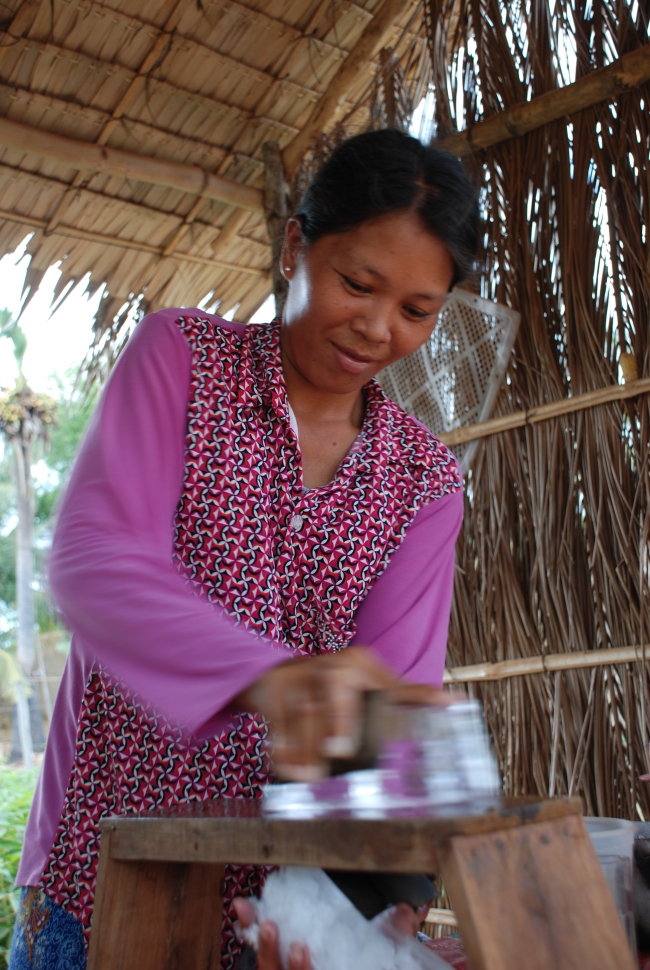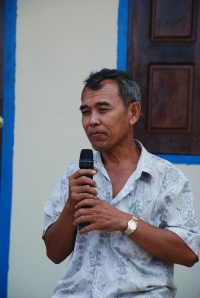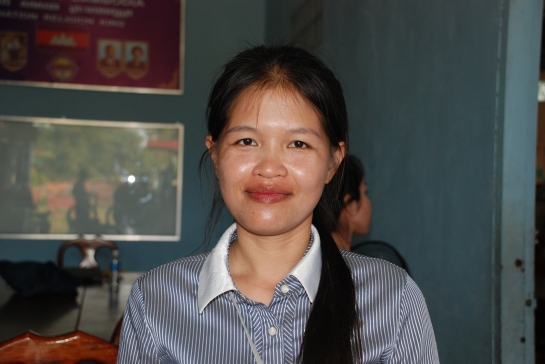One of the features of life in Bakong is the symbiotic nature of small business enterprise and the presence of larger businesses or organisations. The biggest source of business in the area of course is the Bakong Temple itself, and it attracts busloads of tourists. Near where the buses stop several little businesses that have popped up to take advantage of the tourist market. These include food sellers, souvenir sellers, but also small NGOs including one which trains its young children to produce beautiful artwork on leather.
Near Savong school there is a similar presence of local businesses willing to earn a few riel by selling drinks, fruit and snacks to the passing trade of schoolchildren. My favourite of these is in fact no longer there. Opposite the driveway which leads down to Savong’s school used to stand a thatch hut from which a woman, a local farmer, sold iced drinks.
The drinks used to cost something like 200 riel, or just a few cents in the American currency. Yet these drinks were labour-intensive and required resourcefulness on the part of the supplier. For a start, the woman would take a block of ice sourced from a larger retailer a few hundred metres further down the road. She and her young son would cycle down the dusty road to haggle over the price of the ice, and then while we patiently waited for our drinks, she would return triumphant having scored a modest block of ice for a good price. Next, she would shave the ice using a wooden plane with a steel blade. She did this with a proud level of craftsmanship as if she was turning an exquisite piece of teak wood in her honest farmers hands. Now the ice shards would be placed by hand into the plastic cups, and over the ice she would pour a cocktail consisting of condensed milk and a syrupy flavouring. I can tell you, on a crucially hot afternoon in Bakong, I can imagine no refreshment more delicious and enjoyable than this one! As we sipped on the drinks, a couple of teachers and myself, the woman stood there, arms folded, proud of her work and proud to see us enjoying her refreshing concoction.
I have often wondered where the ice comes from in rural Bakong. Things are changing there today, with the arrival of electricity to the area: something which will transform the local refreshment economy. I can imagine there will be no middleman purchasing ice from Siem Reap, and on selling blocks of ice to the myriad drink sellers beer joints and snack vendors in the area. soon there will be the hot hum of small refrigerators struggling to make ice cubes in the face of the scorching heat outside. Such is the way economies restructure themselves, even at a village level.
The Yellow Pages of Cambodia features 26 different companies who manufacture ice. Most of these are situated in Phnom Penh, while at least half a dozen of these companies supply the busy hospitality market of Siem Reap. Perhaps my ice had come originally from the Golden Falcon Ice Factory located on Number 6 Highway close to the centre of town. Or maybe the ice came from another factory just 200 m away from the Golden Falcon ice factory; Heang Hok Kheang. who knows? Somehow the distribution system had enabled a block of ice to be manufactured in town and then stored, wrapped and preserved in muslin fabric, until the mid afternoon.
When I encounter ice in rural remote places of Cambodia I am reminded of the marvellous novel by Paul Theroux called Mosquito Coast. In the story, an American inventor named Allie Fox takes his family to live in the Honduran jungle. In the book, Allie Fox makes a device, a maze of metal tubes, he nicknames “the worm farm” which creates ice. For Fox, ice is one of the greatest signs of civilisation. The man rant and rails that any civilisation can produce fire, but how many can create ice?
It is a hellish book that begins as a simple adventure for the family but descends into an experience not too different to the dystopian, Joseph Conrad inspired Apocalypse Now.
That’s quite a flashback to have while enjoying an icy syrupy drink on a hot afternoon, and thanks to the grace and dedication of that farming woman, the experience I enjoyed was decidedly civilised. Ice in the middle of the village.
Last time I went to Savong school, I looked for traces of her drinks stall. There was nothing there except a few bamboo poles and the remnants of thatching. The woman had lost the stall in a major typhoon that had swept through the Philippines, Vietnam and Cambodia. I can only imagine that any money, any small change that this woman had earned making her gorgeous drinks had been lost in that storm. Today when I look at the photos I took on the day she proudly made me her rural cocktail, I hope she and her family are all right.








You must be logged in to post a comment.